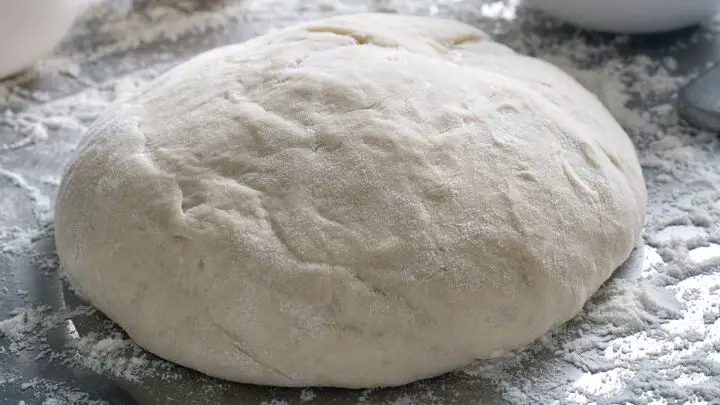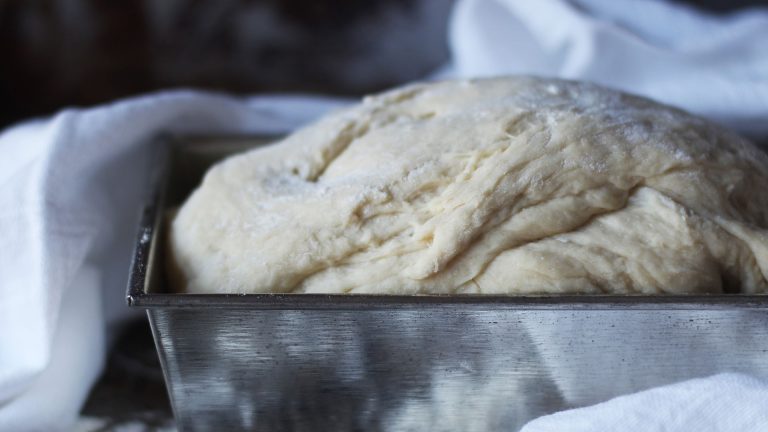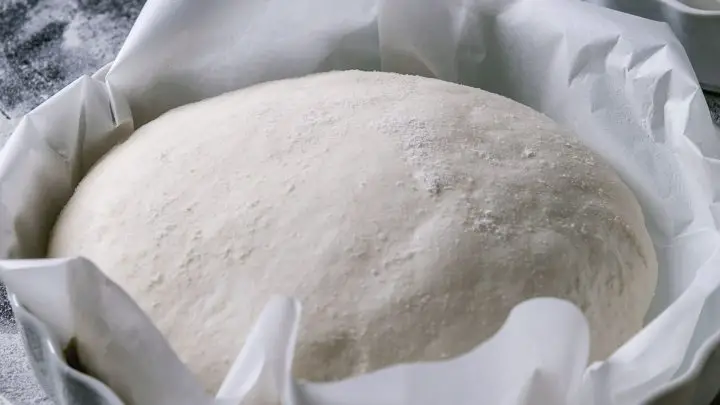The art of perfecting sourdough bread lies in its rise time. This crucial step in making sourdough bread allows the fermentation to work its magic, developing that distinct yet unmissable sourdough flavor and airy texture. While the ideal rising time may vary depending on certain factors like room temperature, starter strength, and desired sourness, a general rule of thumb is to let your dough rise at room temperature. But how long should you let your sourdough rise? Let’s take a look at the details outlined below!

Table of Contents
- What is Sourdough?
- How Long Should Sourdough Starter Take To Rise?
- Can You Let Sourdough Rise at Room Temperature?
- How Long Is Too Long To Let Sourdough Rise?
- Can I Let My Sourdough Rise Overnight?
- How Do You Know When Sourdough Starter is Done Rising?
- Sourdough Starter vs Commercial Yeast
- Basic Sourdough Bread Recipe
- Let Your Sourdough Starter Rise
- FAQs

Basic Sourdough Bread Recipe
Here’s a basic sourdough recipe that you can try out asap.
Ingredients
- 400g active sourdough starter (100% hydration)
- 800g bread flour
- 600g water
- 16g salt
Instructions
- In a large mixing bowl, combine the active sourdough starter and water. Stir until well mixed.
- Add the bread flour to the bowl and mix until a shaggy dough forms.
- Let the dough rest for 30 minutes (autolyze) to allow the flour to fully hydrate.
- Add the salt to the dough and knead or use the stretch and fold technique until the salt is fully incorporated and the dough becomes smooth and elastic.
- Cover the bowl with a damp cloth and let the dough rise at room temperature for 4 to 6 hours, performing a stretch and folding every 30 minutes for the first 2 hours.
- Divide the dough into two equal portions and shape each into a round loaf.
- Place each loaf into a floured banneton or a well-floured kitchen towel inside a bowl.
- Cover the loaves and let them rise at room temperature for another 2 to 3 hours or until visibly expanded.
- Preheat your oven to 450°F (230°C) with a Dutch oven or baking stone inside.
- Once the loaves have risen, carefully transfer them to the preheated Dutch oven or baking stone.
- Score the tops of the loaves with a sharp knife or razor.
- Bake with the lid on for 20 minutes, then remove the lid and continue baking for another 20-25 minutes until the crust turns golden brown.
- Remove the loaves from the oven and let them cool on a wire rack before slicing.
What is Sourdough?
Sourdough is a traditional type of naturally leavened bread characterized by its unique taste and chewy texture. Sourdough relies on natural fermentation through wild yeast and beneficial bacteria that are present in the sourdough starter which is typically a combination of flour and water.
As these microorganisms interact, they produce carbon dioxide which causes the dough to rise naturally. This process also provides the bread with a distinct tangy flavor.
How Long Should Sourdough Starter Take To Rise?
The time it takes for your sourdough starter to rise can depend on several factors.
Typically, a newly fed starter at room temp (70 degrees F-75 degrees F) takes 4-6 hours to reach its peak and double in size. This duration can differ due to variations in the sourdough starter activity, flour type, hydration level, and ambient temperature.
In cooler environments, the rise may take longer compared to a warmer environment.
It’s essential to observe the starter’s visual cues, such as an increase in volume, or a slightly bubbly surface, to determine its readiness for bread making.
Sourdough Second Rise?
The second rise of a sourdough starter, often referred to as the bulk fermentation or proofing stage, depends on multiple factors.
Generally, it can last between 2-4 hours at room temperature. During this stage, the sourdough starter undergoes further fermentation, developing its signature flavor, structure, and texture.
The ideal duration will vary based on the starter vigor, hydration level, and the recipe’s requirements. In cooler environments, a longer second rise may be necessary, while a shorter environment will most likely shorten the time.
Can You Let Sourdough Rise at Room Temperature?
Yes, absolutely.
Sourdough may rise at room temperature. In fact, room temp fermentation is a common method for sourdough baking.
Generally, a newly fed sourdough starter left at room temperature will take between 4-6 hours to double in size.

How Long Is Too Long To Let Sourdough Rise?
Allowing your sourdough to rise for too long can have negative effects on its quality.
While rise time can vary depending on the temperature and activity of your starter, an incredibly long rise exceeding 12-16 hours on the kitchen counter overnight, or 24 hours in the refrigerator, may lead to over-fermentation.
This means that the dough can become incredibly sour, lose its structure, and develop a flat or deflated appearance.
Can I Let My Sourdough Rise Overnight?
Yes, you can certainly allow your sourdough to rise overnight.
An overnight rise or fermentation may take 8-12 hours. It can also be a beneficial technique for developing a more complex flavor profile in sourdough. To do this, you can shape the sourdough dough and place it in the refrigerator for bulk fermentation.
The cold temperature slows down the fermentation process, allowing for an extended rise without over-fermentation. The result is a tangier bread with a desirable texture.
How Do You Know When Sourdough Starter is Done Rising?
Observe its behavior. Look for an increase in volume ideally after the first rise. It should have doubled slightly. Check for a bubbly and airy appearance on the surface of the starter. The starter should show signs of being alive and responsive to feeding. A good indicator is a pleasant aroma suggesting proper fermentation.
Sourdough Starter vs Commercial Yeast
Sourdough starters and commercial yeast are two different types of leavening agents used in sourdough baking.
While a sourdough starter is a naturally fermented mixture of flour and water, commercial yeast is a cultivated strain of single-celled fungi, resulting in a faster and more predictable rise. Sourdough offers additional health benefits and natural preservation properties.
Choosing between the two when it comes to sourdough bread baking relies on your personal preference and desired characteristics of the bread.
Sourdough requires more skill and patience, while commercial yeast provides convenience and consistency.
Basic Sourdough Bread Recipe
Here’s a basic sourdough recipe that you can try out asap.
Ingredients
- 400g active sourdough starter (100% hydration)
- 800g bread flour
- 600g water
- 16g salt
Instructions
- In a large mixing bowl, combine the active sourdough starter and water. Stir until well mixed.
- Add the bread flour to the bowl and mix until a shaggy dough forms.
- Let the dough rest for 30 minutes (autolyze) to allow the flour to fully hydrate.
- Add the salt to the dough and knead or use the stretch and fold technique until the salt is fully incorporated and the dough becomes smooth and elastic.
- Cover the bowl with a damp cloth and let the dough rise at room temperature for 4 to 6 hours, performing a stretch and folding every 30 minutes for the first 2 hours.
- Divide the dough into two equal portions and shape each into a round loaf.
- Place each loaf into a floured banneton or a well-floured kitchen towel inside a bowl.
- Cover the loaves and let them rise at room temperature for another 2 to 3 hours or until visibly expanded.
- Preheat your oven to 450°F (230°C) with a Dutch oven or baking stone inside.
- Once the loaves have risen, carefully transfer them to the preheated Dutch oven or baking stone.
- Score the tops of the sourdough loaves with a sharp knife or razor.
- Bake with the lid on for 20 minutes, then remove the lid and continue baking for another 20-25 minutes until the crust turns golden brown.
- Remove the loaves from the oven and let them cool on a wire rack before slicing.
Let Your Sourdough Starter Rise
Understanding virtual cues, and balancing factors like temperature, starter strength, and fermentation time, are key factors in achieving the perfect rise. With some practisc, bakers can harness the natural magic of wile yeast and bacteria, to produce delightful, and flavorful sourdough loaves.
For more tips on how to get sourdough to rise more, click thru to my blog!
FAQs
How Long Should I Let My Sourdough Ferment?
The ideal fermentation time for sourdough depends on several factors, including room temperature, starter activity, and flavor Generally you should let your starter ferment for 4-6 hours at room temperature or 8-12 hours in the refrigerator.
What Temperature Should Sourdough Be Before Baking?
Before baking, your sourdough should be around 70-75 degrees F. This ensures that the dough is properly proofed and ready for baking.


![[Video – Part 2] Entering Into Peasant Bakery 98 [video] from the seed to the peasant bakery with nicolas supiot](https://www.mydailysourdoughbread.com/wp-content/uploads/2022/11/image-16-120x120.jpeg)



